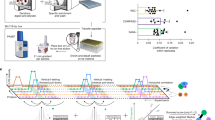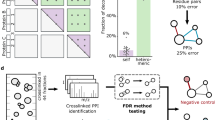Abstract
The functional characterization of genes and their gene products is the main challenge of the genomic era. Examining interaction information for every gene product is a direct way to assemble the jigsaw puzzle of proteins into a functional map. Here we demonstrate a method in which the information gained from pull-down experiments, in which single proteins act as baits to detect interactions with other proteins, is maximized by using a network-based strategy to select the baits. Because of the scale-free distribution of protein interaction networks, we were able to obtain fast coverage by focusing on highly connected nodes (hubs) first. Unfortunately, locating hubs requires prior global information about the network one is trying to unravel. Here, we present an optimized 'pay-as-you-go' strategy that identifies highly connected nodes using only local information that is collected as successive pull-down experiments are performed. Using this strategy, we estimate that 90% of the human interactome can be covered by 10,000 pull-down experiments, with 50% of the interactions confirmed by reciprocal pull-down experiments.
This is a preview of subscription content, access via your institution
Access options
Subscribe to this journal
Receive 12 print issues and online access
$209.00 per year
only $17.42 per issue
Buy this article
- Purchase on Springer Link
- Instant access to full article PDF
Prices may be subject to local taxes which are calculated during checkout



Similar content being viewed by others
References
Karp, R.M. Reducibility among combinatorial problems. in Complexity of Computer Computations (eds. Miller, R.E. & Thatcher, J.W.) 85–103 (Plenum Press, New York, 1972).
Cormen, T.H., Leiserson, C.E. & Rivest, R.L. NP-Completeness. in Introduction to Algorithms 916–946 (MIT Press, Cambridge, Massachusetts, USA, 1999).
Rung, J., Schlitt, T., Brazma, A., Freivalds, K. & Vilo, J. Building and analysing genome-wide gene disruption networks. Bioinformatics 18 Suppl 2, S202–210 (2002).
Mrowka, R., Liebermeister, W. & Holste, D. Does mapping reveal correlation between gene expression and protein-protein interaction? Nat. Genet. 33, 15–16; author reply 16–17 (2003).
Ge, H., Liu, Z., Church, G.M. & Vidal, M. Correlation between transcriptome and interactome mapping data from Saccharomyces cerevisiae. Nat. Genet. 29, 482–486 (2001).
Maslov, S. & Sneppen, K. Protein interaction networks beyond artifacts. FEBS Lett. 530, 255–256 (2002).
Aloy, P. & Russell, R.B. Potential artefacts in protein-interaction networks. FEBS Lett. 530, 253–254 (2002).
Sali, A., Glaeser, R., Earnest, T. & Baumeister, W. From words to literature in structural proteomics. Nature 422, 216–225 (2003).
Weber, J.L. & Myers, E.W. Human whole-genome shotgun sequencing. Genome Res. 7, 401–409 (1997).
Vitkup, D., Melamud, E., Moult, J. & Sander, C. Completeness in structural genomics. Nat. Struct. Biol. 8, 559–566 (2001).
Bader, G.D. & Hogue, C.W. BIND–a data specification for storing and describing biomolecular interactions, molecular complexes and pathways. Bioinformatics 16, 465–477 (2000).
Xenarios, I. et al. DIP: the database of interacting proteins. Nucleic Acids Res. 28, 289–291 (2000).
Orchard, S. et al. Progress in establishing common standards for exchanging proteomics data: the second meeting of the HUPO Proteomics Standards Initiative. Comparative and Functional Genomics 4, 203–206 (2003).
Goldberg, D.S. & Roth, F.P. Assessing experimentally derived interactions in a small world. Proc. Natl. Acad. Sci. USA 100, 4372–4376 (2003).
Saito, R., Suzuki, H. & Hayashizaki, Y. Construction of reliable protein-protein interaction networks with a new interaction generality measure. Bioinformatics 19, 756–763 (2003).
Vasquez, A., Flammini, A., Maritan, A., Vespignani, A. Global protein function prediction from protein-protein interaction networks. Nature Biotechnology 21, 697–700 (2003).
Lappe, M., Park, J., Niggemann, O. & Holm, L. Generating protein interaction maps from incomplete data: application to fold assignment. Bioinformatics 17 (Suppl 1), S149–156 (2001).
Vendruscolo, M., Dokholyan, N.V., Paci, E. & Karplus, M. Small-world view of the amino acids that play a key role in protein folding. Phys. Rev. E Stat. Nonlin. Soft Matter Phys. 65:061910, published online 25 June 2002. DOI: 10.1103/PhysRevE.65.061910
Ito, T. et al. A comprehensive two-hybrid analysis to explore the yeast protein interactome. Proc. Natl. Acad. Sci. USA 98, 4569–4574 (2001).
Uetz, P. et al. A comprehensive analysis of protein-protein interactions in Saccharomyces cerevisiae. Nature 403, 623–627 (2000).
Deane, C.M., Salwinski, L., Xenarios, I. & Eisenberg, D. Protein interactions: two methods for assessment of the reliability of high throughput observations. Mol. Cell Proteomics 1, 349–356 (2002).
Gavin, A.C. et al. Functional organization of the yeast proteome by systematic analysis of protein complexes. Nature 415, 141–147 (2002).
Ho, Y. et al. Systematic identification of protein complexes in Saccharomyces cerevisiae by mass spectrometry. Nature 415, 180–183 (2002).
Acknowledgements
We thank P. Akan, R. Apweiler, M. Ashburner, D. Bolser, D. Bray, G. Cesareni, A. Griffiths, A. Heger, H. Hermjacob, F. Hollfelder, V. Kunin, M. Louis, L. Montecchi-Palazzi, C. Ouzounis, K. Paszkiewicz, T. Schlitt, J. Schulz, E. Ukkonen, M. Vendruscolo, M. Vingron, C. Webber, N. Wyatt, I. Xenarios, Cellzome AG and the IntAct team at the European Bioinformatics Institute for providing resources, valuable feedback and insightful discussions. M.L. is supported by the EMBL International PhD program and Biotechnology and Biological Sciences Research Council (BBSRC) grant 8/C19399.
Author information
Authors and Affiliations
Corresponding author
Ethics declarations
Competing interests
The authors declare no competing financial interests.
Rights and permissions
About this article
Cite this article
Lappe, M., Holm, L. Unraveling protein interaction networks with near-optimal efficiency. Nat Biotechnol 22, 98–103 (2004). https://doi.org/10.1038/nbt921
Received:
Accepted:
Published:
Issue Date:
DOI: https://doi.org/10.1038/nbt921
This article is cited by
-
Learning a hidden uniform hypergraph
Optimization Letters (2018)
-
Embryonic Stem Cell Interactomics: The Beginning of a Long Road to Biological Function
Stem Cell Reviews and Reports (2012)
-
Ontological visualization of protein-protein interactions
BMC Bioinformatics (2005)



